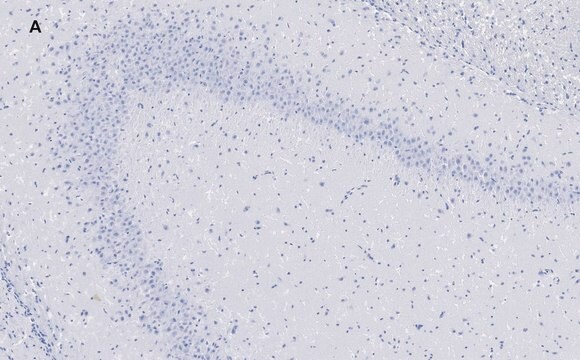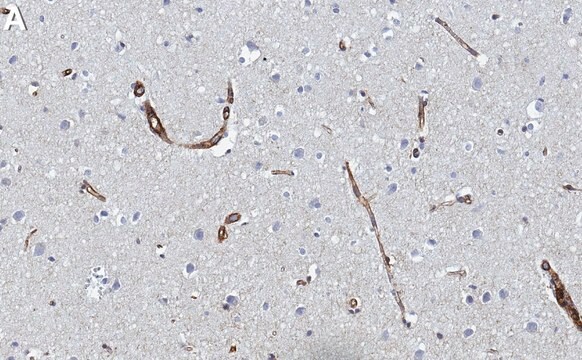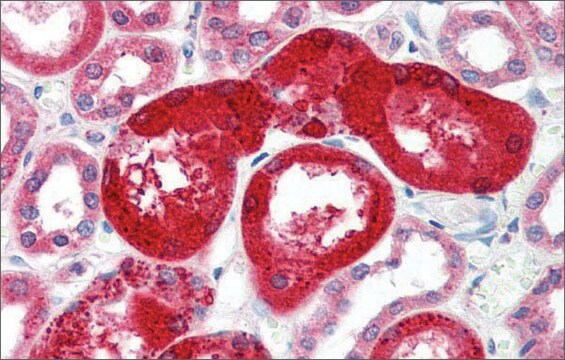MAB88916-C
Anti-Fibronectin (Cell Attachment Fragment) Antibody, clone 3E3, Ascites & Azide Free
clone 3E3, from mouse
Synonym(e):
Fibronectin, FN, CIG, Cold-insoluble globulin
About This Item
Empfohlene Produkte
Biologische Quelle
mouse
Qualitätsniveau
Antikörperform
purified antibody
Antikörper-Produkttyp
primary antibodies
Klon
3E3, monoclonal
Speziesreaktivität
human
Methode(n)
ELISA: suitable
immunocytochemistry: suitable
immunohistochemistry: suitable
inhibition assay: suitable
western blot: suitable
Isotyp
IgG1κ
NCBI-Hinterlegungsnummer
UniProt-Hinterlegungsnummer
Versandbedingung
wet ice
Posttranslationale Modifikation Target
unmodified
Angaben zum Gen
human ... FN1(2335)
Allgemeine Beschreibung
Immunogen
Anwendung
Zellstruktur
ECM-Proteine
Immunohistochemistry Analysis: A 1:500 dilution from a representative lot detected Fibronectin (Cell Attachment Fragment) in human placenta and liver tissues.
ELISA Analysis: A representative lot detected the conformation of Fibronectin adsorbed onto self-assembled monolayers (SAMs) of alkanethiols over a range of Fibroectin surface densities (Kesolowsky, B. G., et al. (2003). J Biomed Mater Res A. 66(2):247-259.).
Immuncytochemistry Analysis: A representative lot detected Fibronectin (Cell Attachment Fragment) in Extracellular matrix deposited by HUVECs (Orecchia, A., et al. (2003). J Cell Sci. 116(Pt 17):3479-3489.).
Inhibition Analysis: A representative lot blocked cell-adhesive epitopes of Fibronectin (Cell Attachment Fragment) (Miller, D. C., et al. (2005). J Biomed Mater Res A. 73(4):476-84.).
Inhibition Analysis: A representative lot blocked RGD-dependent cell adhesion (Tsang, T. M., et al. (2012). J Biol Chem. 287(20):16759-16767.).
Inhibition Analysis: A representative lot inhibited the cell-adhesive epitopes of Fibronectin (Miller, D. C., et al. (2005). J Biomed Mater Res. 73(4):476-484.)
Qualität
Western Blotting Analysis: 0.5 µg/mL of this antibody detected Fibronectin (Cell Attachment Fragment) in 10 µg of HepG2 cell lysate.
Zielbeschreibung
Physikalische Form
Lagerung und Haltbarkeit
Handling Recommendations: Upon receipt and prior to removing the cap, centrifuge the vial and gently mix the solution. Aliquot into microcentrifuge tubes and store at -20°C. Avoid repeated freeze/thaw cycles, which may damage IgG and affect product performance.
Sonstige Hinweise
Haftungsausschluss
Sie haben nicht das passende Produkt gefunden?
Probieren Sie unser Produkt-Auswahlhilfe. aus.
Lagerklassenschlüssel
12 - Non Combustible Liquids
WGK
WGK 1
Flammpunkt (°F)
Not applicable
Flammpunkt (°C)
Not applicable
Analysenzertifikate (COA)
Suchen Sie nach Analysenzertifikate (COA), indem Sie die Lot-/Chargennummer des Produkts eingeben. Lot- und Chargennummern sind auf dem Produktetikett hinter den Wörtern ‘Lot’ oder ‘Batch’ (Lot oder Charge) zu finden.
Besitzen Sie dieses Produkt bereits?
In der Dokumentenbibliothek finden Sie die Dokumentation zu den Produkten, die Sie kürzlich erworben haben.
Unser Team von Wissenschaftlern verfügt über Erfahrung in allen Forschungsbereichen einschließlich Life Science, Materialwissenschaften, chemischer Synthese, Chromatographie, Analytik und vielen mehr..
Setzen Sie sich mit dem technischen Dienst in Verbindung.







